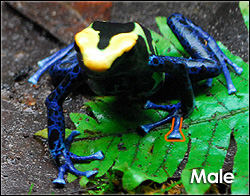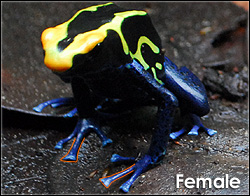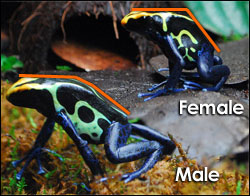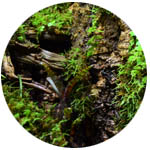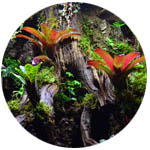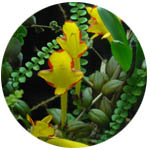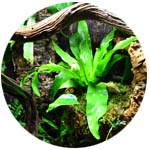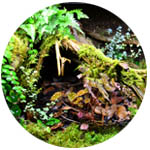
Dendrobates tinctorius Care
A detailed guide pertaining to the care of the many morphs of D. tinctorius dart frog
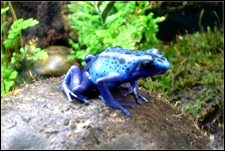

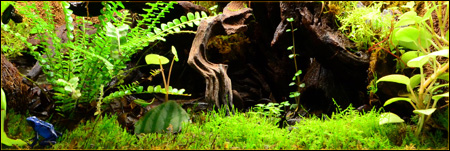

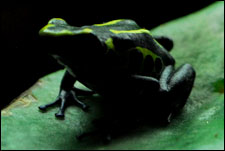
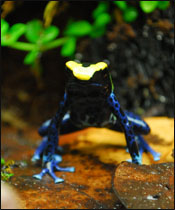
Description
This guide is appropriate for use with all the most commonly available tinctorius morphs. From the larger morphs like T.'Citronella', to the smaller morphs like T. 'Bakhuis', this species of frog has an incredible amount of variation between morphs & locales. All morphs are diurnal, meaning they are awake during the day and sleep at night, making them a wonderful display animal. Considering the brilliant coloration, outgoing nature, and ease of caring for these frogs; it's no wonder why they are the most popular species of dart frog kept today. This guide will help describe the general husbandry necessary to help your frogs thrive & even breed in captivity.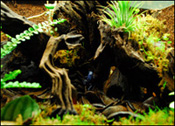
Housing
We recommend a bare minimum of 10 gallons of space per frog. Most morphs of tinctorius do best when kept in male/female pairs. These are mostly terrestrial animals, and do best in an enclosure that is wider than it is tall. While they will climb occasionally, the majority of their time will be spent on the floor of the terrarium. Ground cover above the substrate should be comprised mostly of sterilized leaf litter, with live moss filling in spots only for aesthetics. Remember that in it's native habitat, leaf litter makes up nearly all of the ground cover they walk on. While a lush carpet of live moss may look great to us, it's not the most natural option available. Temperature should ideally be kept at 68-78F during the day, with drops as low as 65F at night being acceptable. Heat is a real concern, as temperatures over 80F can cause stress a frog and even lead to death. Ideal relative humidity is above 80%, which requires a well-designed habitat to accomplish easily. Screen tops are inappropriate for dart frogs, and at least partial glass tops should be used. Although ventilation in a live vivarium isn't necessarily required, at least some air movement is beneficial to the frogs & plants. We've had success leaving a 1.5-2in screen area across the width of the enclosure, with the rest sealed with a glass top to hold in humidity. A live vivarium is generally considered a necessity for the long term husbandry of these frogs. If you are new to vivariums, please do your research before purchasing a dart frog, as any other condition in captivity is considered sub-par.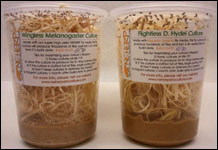
Feeding
Most tinctorius froglets will eat D. melanogaster flies, and will quickly become large enough for D. hydei as they age towards maturity. Ideally, we suggest offering however many flies a frog will eat in 15-30 minutes or so. The appropriate amount will range heavily depending on the age/size of a frog. Adding too many flies can stress a frog, so start slow by adding only a dozen or so flies & going from there. If your frog quickly gobbles up all the flies in it's enclosure, there's a good chance you can offer a little more next time. If you see an excess amount of flies left over in the enclosure an hour or so after feeding, chances are too many flies were added.Supplementation
In nature, these animals would eat a variety of small arthropods, insects, arachnids, and more. Even a "varied diet" in captivity won't come close to offering the frogs all the nutrition they would otherwise encounter the enormous assortment of edible critters naturally found on the Jungle floor. For that reason, keepers of Dendrobates tinctorius frogs must provide a complete variety of nutrition, to supplement the frog's captive diet. To supplement a frog, simply dust it's feeder flies with the appropriate vitamin powder before feeding. This is most often accomplished by adding some powder to an empty deli cup, adding flies, and shaking them up gently. There are a number of extremely poor quality supplements available on the market, which is why we only carry Dendrocare, Rep-Cal, and Repashy brands. In our experience, they are the best supplements available on the market today. Below is a list of all the commonly available supplements, and is not a list of everything which should be used! For the sake of simplicity, we usually break the market of supplements into 4 categories. Calcium, multivitamins, calcium/multivitamin blends, and "other supplements".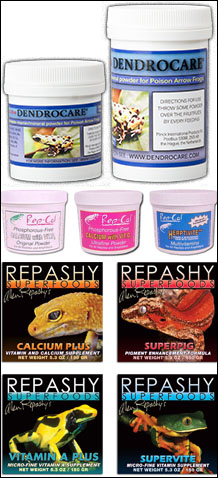
Examples Of Available Supplements:
• Rep-Cal Calcium With Vitamin D3 Original Powder (White Jar)
• Rep-Cal Calcium With Vitamin D3 Ultrafine Powder (Pink Jar)
• Repashy Supercal LoD (low Vitamin D3 content)
• Repashy Supercal MeD (medium vitamin D3 content)
• Rep-Cal Herptivite (Blue Jar)
• Repashy Supervite
• Dendrocare
• Repashy Calcium Plus (Original for frogs without UVB lights)
• Repashy Calcium Plus (LoD for frogs with UVB lights)
• Repashy Superpig (A carotenoid supplement)
• Repashy Vitamin A+ (A Vitamin A supplement)
These are the basic building blocks for a healthy herp, and are necessary for the animal to thrive in captivity. Calcium helps in many ways, with it's most apparent being the formation & support of bone structures. Phosphorous & Vitamin D3 help the frog absorb & use this calcium naturally, which is why the three (Calcium, Phosphorous, and D3) are so commonly packaged together. Vitamin D3 can be supplemented in a powder, and also by providing UVB lighting for the animal to naturally absorb some D3. Beyond those three, there are plenty of other nutrients which are included in multivitamin supplements. (Vitamins A, E, B1, B2, B6, Potassium, Iron, Magnesium, Zinc, just to name a few) Hobbyists can either alternate between a Calcium supplement and a Multivitamin supplement, or simply use a single Calcium & Multivitamin blend. At NEHERP, we supplement our frogs with a calcium & multivitamin blend at every feeding.
The addition of a carotenoid supplement is ideal. Carotenoids are naturally occurring pigments found in many different species of plants, algae, and bacteria, which help frogs produce bright, natural coloration, as well as provide other health benefits. It wasn't long ago that many hobbyists looked at Carotenoids as "just a way to make animals have improved color", but that is proving not to be the case. A recent study by Tulane University's Department of Ecology & Evolutionary Biology showed that an increase of carotenoids in a Pumilio frog's diet positively affected it's level of reproductive success, and produced a higher number of healthier frogs. At NEHERP, we supplement our frogs with Repashy Superpig once weekly.
The addition of preformed Vitamin A into a dart frog's diet is important because some supplements rely on Beta Carotene as a source of convertible Vitamin A. From what we understand, this may not be an ideal source for this particular species, as they may not be able to convert Beta Carotene into usable Vitamin A, or Retinol. Many breeders in the hobby have described overall healthier frogs, as well as a decrease in the number of froglets morphed with SLS ("spindly leg syndrome") when the parent frogs were offered a diet complete with a usable form of Vitamin A. It is possible to over-supplement a frog with Vitamin A, causing potentially toxic condition called hypervitaminosis. For this reason, it's critical to follow the instructions on the package of Repashy Vitamin A+, to ensure proper use. At NEHERP, we offer Repashy Vitamin A+ once monthly to adult frogs, and once every other month to froglets.
At NEHERP, we supplement our frogs at every feeding with a Calcium & Multivitamin blend (either Repashy Calcium Plus, or Dendrocare), once weekly with Repashy Superpig, and once monthly with Repashy Vitamin A+. Froglets are supplemented with Vitamin A+ bi-monthly.
Water
Frogs do not "drink" in the traditional, human sense. They absorb water through their skin, so misting is very important. This species does not require a water area, water bowl, water fall, or any other water feature to thrive, so long as the vivarium is properly designed & misted frequently. In fact, open pools of stagnant water can grow bacteria at an alarming rate, so we usually suggest against typical water bowls being added into dart frog vivariums unless you are planning on breeding. (Water sites are often used for tadpole deposition, which we'll cover a few paragraphs down) Mist 2+ times per day using dechlorinated water in an effort to hydrate your frogs & to maintain 80%+ humidity within the enclosure. Appropriate types of water include dechlorinated tap water, reverse osmosis water, and spring water. Avoid bottled waters with added sodium or other chemicals, as well as distilled water which is thought to pull nutrients out of the soil to level itself out.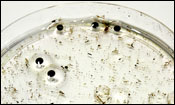
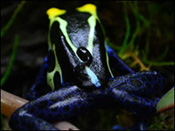
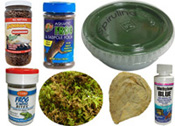
Eggs & Tadpoles
These frogs are sexually mature at around 12-18 months of age, and keepers commonly see successful clutches being dropped around the 14-month mark, or sooner in some cases. The male's call is very quiet & low, and may not be audible from outside the vivarium. Our 'Azureus' females always deposit eggs in either film canisters (seen above), or in coconut huts with a petri dish as a floor. From our experience, the first few clutches of eggs per season are more prone to going bad until the 2'nd or 3'rd clutch is dropped, when the eggs start to develop properly. Eggs can either be left to develop in-vivarium, or removed to be incubated and cared for outside the vivarium. Both methods have advantages & disadvantages, as described below:This method is probably the easiest, but has slightly lower percentages of hatch/morph rates. During the following process, the vivarium's temperature should be kept at a steady 75-77F if possible. With this method, the egg deposition site (commonly a film canister, petri dish, or similar) will remain inside the enclosure until the eggs develop & hatch into tadpoles. It's critical to ensure there's enough water (we use reverse osmosis filtered water) in the petri dish to completely surround, but not submerge the egg mass. When the eggs hatch into tadpoles, an adult frog (most often the male) will transport the tadpoles on their back to a suitable tadpole deposition cup after they hatch. The deposition cup can be anything from a fancy water bowl, to a very simple small (2.5-8oz) deli cup. It should contain tadpole tea (described below), and some breeders also add Indian Almond Leaves and/or tadpole moss to the cup. We suggest offering at least 2 deposition cups in each vivarium for the frogs to choose from. Once transported into the deposition cup, the tadpole(s) should be removed from the vivarium and placed into their tadpole rearing cup, as explained in the 'rearing hatched tadpoles' one paragraph below.
This method is a little more difficult, but has higher successful hatch/morph rates. With this method, the container/surface where the egg mass was deposited should be carefully removed from the vivarium when found. The egg mass must then be carefully transferred from the egg-laying site to a sterile petri dish. (Unless the mass was deposited on a petri dish, in which case you are ahead of the game!) Transferring the egg mass onto a petri dish can be a stressful procedure until you are accustomed to doing so. Proceed very carefully, and do your best to not disturb the egg mass any more than necessary. Once it's transferred to a petri dish, the egg mass should be surrounded (not submerged) by a standard methylene blue solution to proactively prevent any fungal issues from developing. (1 drop methylene blue per gallon of reverse osmosis water.) We personally incubate eggs at 76F (+/-1F) for the highest rate of success. Once the eggs in the petri dishes hatch into tadpoles and begin swimming around in the surrounding water, they can each be moved into a separate 16oz tadpole development cup. (In nature, they would be transferred on the male's back to the new water-filled location at this time.)
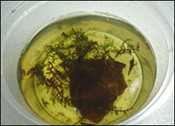


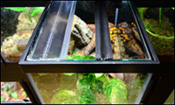
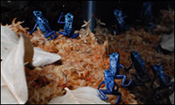
Rearing Hatched Tadpoles & Morphed Froglets
We suggest raising tadpoles individually for the most successful morph rate. We fill 16oz deli cups about 2/3s of the way with R/O water to start, then add an Indian almond leaf piece, a pinch of moss, and a little splash (maybe 1oz) of diluted methylene blue solution to the mix to help protect against infections. The Indian almond leaf will add beneficial tannins to the water, creating a "tadpole tea" (also called "black water") similar to what's found in the native habitat. Ideally, each tadpole rearing cup should be prepared for a day or two before introducing the tadpole, to allow the tannins to absorb into the water. Breeders of a larger scale will benefit from making tadpole tea in advance, by simply adding Indian Almond Leaves to a larger container of water which can be refrigerated for 2-3 weeks until it's ready to be used. (Remember to warm it up before adding tadpoles!) Freshly hatched tads usually won't eat for a few days, so adding food should be delayed for 2-3 days to prevent fouling of the water. For all of our tinctorius species, we cover our bases and offer half-a-pinch of Spirulina powder (or flakes), a pinch of Repashy Soilent Green, 1-2 pieces of HBH tad bites, 1-2 pieces of Zoo Med tadpole food, and a single bloodworm per 16oz cup to start. We feed once every 3-4 days at the beginning, and more frequently as the tadpole matures towards morphing. Never offer more than one bloodworm at a time, as they can very quickly foul the water. With all the food offered, always watch what's left before adding more. If the tadpole still has plenty of what you offered 2 days ago, don't add more food. The tadpole should morph into a froglet around 35-45 days. It's back legs will develop 1'st, then it's fronts will develop and eventually "pop"; marking the moment it's able to be transferred to the grow-out container. While the tad is in it's 16oz development cup, water changes are usually considered optional. We personally only do partial water changes if the water gets noticeably darker than usual. (Think the color of Nestea, for example) If you choose to do water changes, be sure to use filtered (reverse osmosis if possible) water pre-warmed to proper temperatures so as not to stress the tadpole.Sexing Frogs
Most tinctorius species can be accurately sexed around 10-12 months of age (sometimes sooner). There are a number of ways to go about this, with each being a little more or less accurate than the other. Using all three methods together is usually a pretty good way to get an idea of your frog's sex.